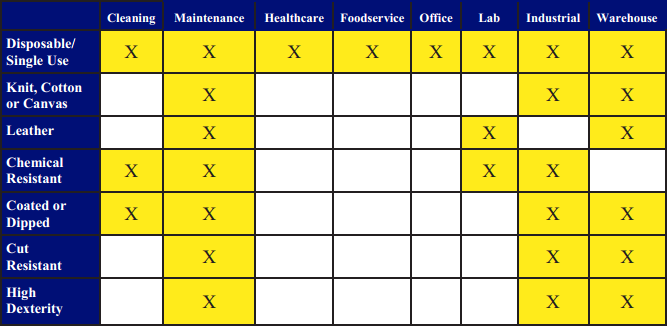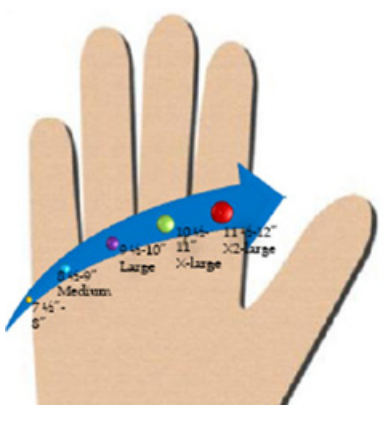Hand injuries account for approximately 1,000,000 injuries annually. 70% of the workers who experienced hand injuries were not wearing gloves. Source: U.S. Bureau of Labor Statistics
Types of Gloves
Disposable/Single Use Gloves
- Reliable and economical protection
- Uses: Small part handling, food handling, medical & lab use, manufacturing
- Material: Latex, Nitrile, Vinyl, PVC
- Nitrile and vinyl are great alternatives for those with latex allergies
- Ideal for tasks when greater dexterity is needed
Leather Gloves
- Provides durability, dexterity and comfort
- Uses: general and medium-duty tasks
- Drivers gloves (shown right) are a popular type of leather glove
- Palms with PVC dots, natural or synthetic hide provide greater grip when needed
- Lined leather gloves provide added warmth in cold environments
Knit, Cotton or Canvas Gloves
- Fibers are knitted together in glove pattern
- Uses: light-duty tasks
- Allows hands to breathe and reduce perspiration
- Provides protection and dexterity
- Can be used as a liner for extra protection
- PVC dots also provide extra grip
Chemical Resistant Gloves
- Protects hands against a wide variety of chemicals
- Uses: general cleaning, chemical processing
- Materials: PVC, Rubber, Neoprene, Nitrile, Rubber
- Delivers a varying degree of cut protection and enhanced grip
Coated or Dipped Gloves
- Glove is dipped in a polymer coating for added protection
- Uses: chemical handling, cleaning, oil refining, food processing
- Coatings protect against solvents and chemicals, abrasions, punctures and cuts
Cut Resistant Gloves
- Protects hands from sharp edges such as blades, glass, metal, ceramics, etc.
- Uses: medium to heavy-duty tasks
- Materials can vary, such as Kevlar, Spectra or composite yarns
- Not effective in protecting against punctures or power equipment
Dexterity Gloves
- Extra padding offers more protection
- Uses: tasks that require superior protection but with dexterity, grip and working with small parts
- Eliminates fumbling with small objects
Facts and Tips about Gloves
- Gloves protect your hands from the following workplace hand injuries: sharp objects, abrasive sur-faces, moving components, wet environments, chemicals, blood-borne pathogens and viruses.
- You must follow a safe procedure for removing gloves so soil, chemicals or viruses do not come into contact with your hands. Remove one glove from top to bottom with the other gloved hand.
- Then, tuck the first glove in the other gloved hand and peel off the second glove from the inside.
- The glove cuff style is an important consideration based on the protection needed. Some cuffs will allow the glove to be removed quickly or allow ventilation.
- There are several standards and ratings for cut resistant and coated gloves (i.e. EN, ANSI, ASTM, etc).
- Compare similar standards when choosing gloves because ratings can be determined based on different testing methods.
- If you have an allergy to latex or rubber, look for gloves that contain no latex such as vinyl or nitrile.
Size and Fit Matter
- Size and fit is very important to properly protect your hands.
- Poorly fitted gloves will not be worn and increase the chance for hand injuries.
- Too small: make hands fatigue while providing less dexterity and decrease productivity
- Too big: more likely to get caught in moving components and not have proper dexterity.
- Measure your dominant hand with a tape measure around the palm and knuckles.
General guidelines for men’s sizes
- 7.5-8” - Small
- 8.5-9” - Medium
- 9.5-10” - Large
General guidelines for women’s sizes
- 6” - X-Small
- 6.5” - Small
- 7” - Medium
Questions to Consider When Buying Gloves
- In which task or application will you be wearing gloves for protection?
- What types of gloves do you use? Why?
- What types of hand injuries happen in your work area?
- What do you like or dislike about your gloves?
- If you can change one thing about your gloves, what would it be?
- What are the costs of the gloves you have purchased recently?
Gloves By Application
There is no one glove that will fit each job or situation. Assess the job and protection needed to purchase
the right glove. Below is a chart that shows the types of gloves commonly found in various applications.




